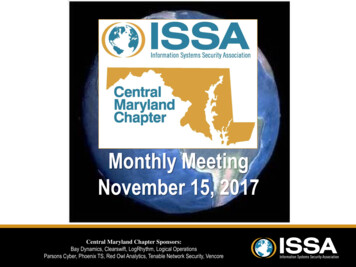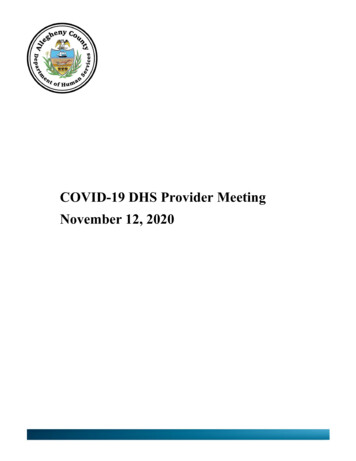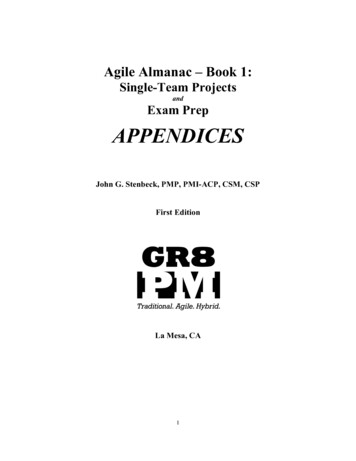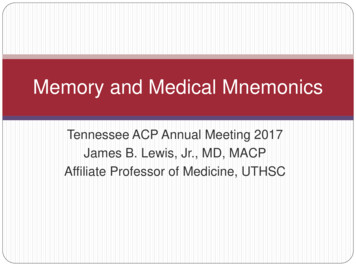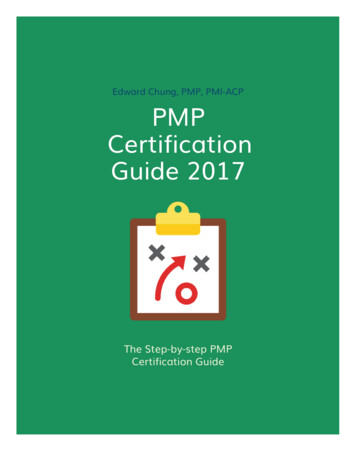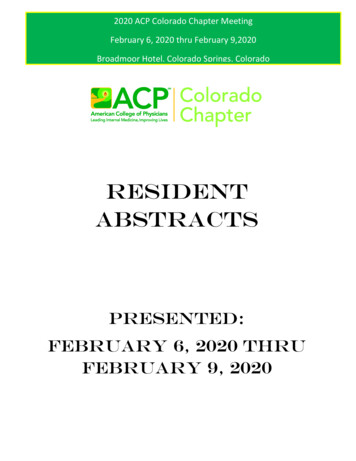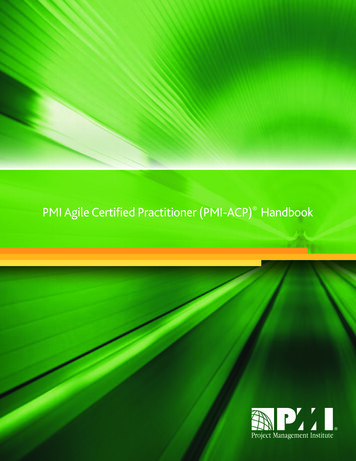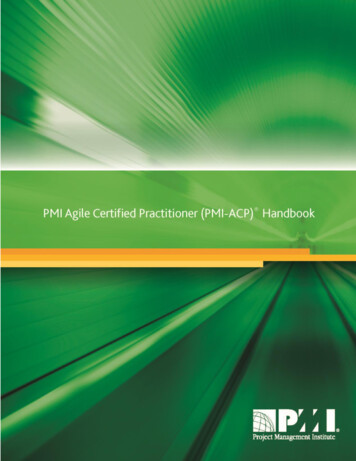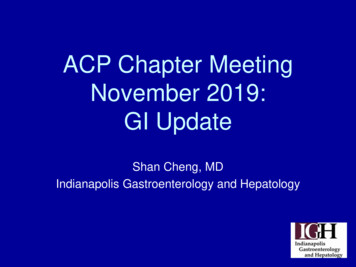
Transcription
ACP Chapter MeetingNovember 2019:GI UpdateShan Cheng, MDIndianapolis Gastroenterology and Hepatology
ACP GI Update1. Ulcerative colitis/IBD- Diagnostics- Focus on therapy2. Pancreatic cystic disease3. Complementary/alternative medicine infunctional GI disease (IBS/Functionaldyspepsia)
Chapter I:Ulcerative Colitis/Inflammatory BowelDiseaseACG Clinical Guidelines 2018AGA Clinical Practice Guidelines 2019
Inflammatory Bowel Disease Two major diseases– Ulcerative colitis:Mucosal inflammation in the colon– Crohn’s disease:Transmural inflammation throughout the GI tract Chronic inflammatory condition affectingthe GI tract of variable severity, location,symptoms pattern Autoimmune pathways
The Clinical Presentation andWorkup of Ulcerative Colitis
62 year old male presents to clinic withdiarrhea and rectal bleeding .
HPI Points DurationSeverity – Nocturnal, incontinenceFevers, sweatsPrior workupAssociated extraintestinal symptoms– Rash– Joint pain– Ocular disease Anorectal diseaseAssociated autoimmune conditionsPainFamily history – 10%
62 year old male p/w 10 weeks of recurrentdiarrhea with multiple episodes of passingblood. Had some alteration in bowel habitsin school years and prior colonoscopy at age55 was normal except for hemorrhoids.Describes over 8 bm/day with occasionalnocturnal symptomsCBC notable for WBC 8, Hgb 8.1, MCV 68
Exam Pale Abdominal exam non-specific Severe disease – Hemodynamicinstability, signs of malnutrition
ExamAsk about skin changesErythema Nodosum
ExamMore skin changesPyoderma gangrenosum
ExamRectal and Peri-analExam
Labs CBCBMPLFTsESRCRPConsider sprue serologiesStool studies more useful in acute phasedisease
Imaging CT scan Abdominal plain films Small bowel imagingstudies – evaluatingfor Crohn’s– Small bowel followthrough– CT or MRenterography– Capsule endoscopy
Differential Diagnosis MalignancyIBD – Ulcerative colitis vs Crohn’sFunctional GI – IBS et alInfectious colitis/STDIschemia Diverticular colitis NSAIDs effects Radiation colitisIn this patient also consider workup for upper GI tractpathology
Colonoscopy
Colonoscopy tyBleeding
Pathology Findings Chronicity Crypt abscesses Lymphocytic andplasma cellinfiltrates Absence/Presenceof granulomas –reconsider Crohn’s Rule out CMV
What is Ulcerative Colitis (UC)? Recurrent episodes of mucosalinflammation of the colon Rectum and extending proximal – typicallycontinuous Imbalances between pro- and antiinflammatory cytokines at the gut lumen Genetics/infectious/environmental theories
Epidemiology of UC Prevalence – 240 per 100,000M FSlightly lower rates in non-whitesBimodal incidenceAbx/Isotretinoin ?Smoking
Formal Definitions of Severity Mild disease - Majority– 4 bm/day with or without blood– Mild pain– No systemic toxicity Moderate disease– 4 loose/bloody stools– Mild anemia– Non-severe pain Severe disease– 6 bm/day– Severe pain, systemic toxicity, anemia, weight loss
Targeted Goals of Therapy Less than 2-3 bm/dayNo severe urgencyNo bleedingNo significant pain/cramping
Worst Case Scenerios Fulminant colitisToxic megacolonPerforationSevere bleedingSevere stricturing
Worst Case Scenario Colon cancer– Extent, duration, and severity– Increased risk after 8-10 years duration ofdisease– 1-2%/year after 10 years– Recommend 1-2 year surveillance after 10 years– Additional risk factors: Family history of colon cancer doubles risk Pseudopolyps Primary sclerosing cholangitis
Treatment forUlcerative Colitis Aminosalicylic acid (ASA) classSteroidsImmunomodulatorsBiologicsSurgery
Treatment – ASA ClassASA (5-aminosalicylic acid)/Mesalamine Class Anti-inflammatory Good for mild and moderate disease Sulfasalazine is oldest and cheapest Modern agents composed of Mesalamine bound tocarrier molecules with various timing/dosing of saLialdaApriso
Treatment – ASA ClassMultiple Routes Oral – Dosing generally 1.2-4.8 g/day Enema – Once to twice daily– Better response rates for left-sided disease– Reaches splenic flexure/sigmoid colon Suppository – Once to twice daily for disease confined todistal 5-8 cm of rectum
Treatment – ASA Class Still controversial regarding colon cancerprevention Uncommon but multiple cases whereexacerbates symptoms At least yearly BMP – Rare renal side effects No increased risk with higher dosing Poor compliance Dose daily or bid Ok in pregnancy and probably lactation
Treatment - Steroids Prednisone– Start high, slow taper– Significant side effects– Should not be afraid of acutetoxicity, be very afraid of long-termeffects Topical therapy withhydrocortisone enemas or foam– Not for maintenance– Quote 10-20% absorption
Treatment - Steroids Budesonide (Entocort, Uceris)– Few systemic side effects, less adrenalsuppression– ? Role in disease management– Problematic insurance coverage
Treatment - Immunomodulator6MP (6-Mercaptopurine) orazathioprine (Imuran) Inhibit lymphocyte proliferation Considered for a long time, first-linefor moderate severity, steroid sparingtherapy Variable dosing Slow onset of activity Important to check regular labs
Treatment - Immunomodulators Complications of 6MP and Imuran– Marrow suppression– Hepatotoxicity– Pancreatitis– Constitutional symptoms/GI upset– Lymphoma
Treatment – Biologics Monoclonal antibodies directed againstspecific inflammatory pathway targets 60-70% response rates Well-tolerated Rapid onset
Treatment – Anti-TNF Remicade – Infusion (maintenance every 6-8wks) Humira – SubQ every other week Cimzia – SubQ or infusions q 4 weeksDeciding factors Insurance Patient preference Compliance Pregnancy
Treatment – Anti-TNFAdverse effects Cost/Insurance Psoriasis (paradoxical response) Allergic response Lymphoma Infection/Sepsis
New(er) Biologics Entyvio (vedolizumab)– Monoclonal antibodies targeting gut-selectiveintegrins– Good safety experience Stelara (ustekinumab) – Approved forCrohn’s– Monoclonal antibodies targeting IL-12/23– Less frequent dosing– Good psoriasis data
Treatment – Maintenance forModerate or Severe Disease Guided by steroid requirementFactor in distributionProponents of top-down therapyDecisions often guided by acuityGood data for combined immunomodulatorand biologic therapy in Crohn’s Role for monitoring therapy (6MPmetabolites, Humira/Remicade assays)
Treatment - Symptomatic LoperamideAnti-spasmodicsFiber/bulking agentsCholestyramineProbioticsJust be careful
Treatment - Other Dietary– Bowel rest– Elemental diet– TPN Enteragam– Case reports
Treatment - Surgical Indications– Medically non-responsive– Cancer– Toxic megacolon– Refractory bleeding– Fulminant colitis not responding to medicaltherapy
Treatment - Surgical Total proctocolectomywith end ileostomyIBDrelief.com
Treatment - Surgical Totalproctocolectomywith ileal pouch analanastomosis (IPAA,J-pouch)– 3-8 bm/day– Pouchitis in 7-33% Intermediateapproaches in astaged fashion
Inpatient Points Acute infectious colitis vs. new UC ischallenging IV steroids Antibiotics for systemic toxicity Colectomy in 5-10% of patients within thefirst year– Fulminant colitis failing medical therapy within7d
Fulminant Colitis Severe colitis with systemic toxicity; ongoingbleeding, pain, diarrhea; often fever andanorexia Treatment– Antibiotics– NPO– Evaluate for colon dilation (generally 6cm andcecum 9cm)– IV steroids– Consider for biologic therapy– Colectomy
Outpatient Points Major overlap with IBS– Objective measures with goal toward mucosalhealing Caution with narcotics Proactive care Compliance can be hard
UC vs. Crohn’s UC therapy principles apply to Crohn’s colitis Differences––––Discontinuous involvementSurgeryRate of escalating therapyProximal disease Poor response to ASA Earlier role for IM or Biologic therapy– Fistulizing disease– Smoking
Chapter II:Pancreatic Cystic DiseaseShan L. Cheng, MDIndianapolis Gastroenterology andHepatology
Pancreatic cysts Common!– 40% incidence in patients over 70 incidentallyon MRI Overall risk of malignant transformation isquite low– Risk of cancer present at time of finding0.25% with conversion rate 0.24%/year Mortality rate of pancreatic cyst surgery2.1%. Morbidity rate 30%ACG Clinical Guidelines 2018
Two Types of CystsNon-NeoplasticNeoplastic Pseudocysts IPMN - Intraductal papillarymucinous neoplasm MCN - Mucinous cysticneoplasm (nocommunication with duct) Serous cystadenoma (rare,honeycomb, central scar, verylow risk) Solid pseudopapillaryneoplasm (rare, young women,behaves like low gradepancreatic adenoca surgery) Neuroendocrine s-cystic-lesions
Hpbleicester.org
Pseudocyst Associated with acute and/or chronicpancreatitis Fluid /- debris Less common than neoplastic cysts EUS can be useful to delineate chronicpancreatitis and If aspirated, highamylase, low CEA
IPMN – Intraductal PapillaryMucinous Neoplasm The most common type of pancreaticcysts 40% multifocal Men Women 7th decade
IPMNSide Branch (BranchDuct) Most common cyst Low risk ofprogressionMain Duct High risk ofmalignancy with38-68% risk of highgrade dysplasia inspecimens
High Risk Characteristics ofIPMNsClinical Jaundice Acute pancreatitisrelated Elevated serum19-9Imaging: Mural nodule orsolid component Main pancreaticduct diameter 5mm or change inupstream duct Size 3 cm orincrease 3mm/yr
If High Risk Characteristics Endoscopicultrasound Referral tomultidisciplinaryHPB group– Advancedendoscopists– HPB surgery
EUS1. Useful to identifycyst types- Appearance, CEA,Amylase2. Evaluate forhigher gradedysplasia andcancer
Imaging/Surveillance Goal of imaging is toassess type of cyst andrisk of progression 3cm needs likelysurgery input and closemonitor Varying intervals ofimaging monitor basedupon cyst size. Stablesize over 3-5 yrs meansmalignancy unlikely MRI/MRCP slightlysuperior but CT/EUS arestill good alternatives
Final recommendations Patients who are not medically fit forsurgery do not need further evaluation forincidentally found cystic disease MRI/MRCP is the preferred test forsurveillance 3 cm size, main duct involvement/dilationor associated symptoms (jaundice,pancreatitis) are concerning features
Chapter III:Update on Complementaryand Alternative Medicinefor FunctionalGastrointestinal Disease
Complementary and AlternativeMedicine (CAM) Defined as medical practice notconsidered to be part of “traditionalmedicine” Complementary medical practice is takenin conjunction with conventional medicine Alternative medical practice is taken orused in place of conventional medicalpracticeKoretz 2004
Shifting Definitions of CAMInfluences of: Culture Ethnicity Religion Education Economic forces Attitudes of local medicalpractitionersHussain 2006
CAM Practices Biologic-based therapies– Herbal products and dietary constituents or additivesfound in nature Manipulative and body-based treatment– Acupuncture, massage, chiropractic or other bodybased manipulation Mind-body interventions– Meditation, hypnosis, psychologic therapy Alternative medical systems– Homeopathy, traditional Chinese medicine
Complementary and AlternativeMedicine (CAM) – U.S. Market 35% of U.S. population used someform of CAM between 1997-2002 From 2012 NIH Survey data– Total of 30 billion/year– 14.7 billion on practitioners– 12.8 billion on supplementsvan Tilburg 2008Blumenthal 2001
What is Driving These Trends?Consumer Appeal for CAM1. Perception that natural therapies may besafer and more effective2. Sense of active participation in medicalcare through holistic approach3. Utilization in the most difficult to treatchronic medical ailments
Functional GI Disease Disease from altered physiologic functioninstead of identifiable structural orbiochemical cause Lack of structural target emphasizessymptom-based management Most patients and physicians aredissatisfied with current treatment optionsvan Tilburg 2008
Functional GI for the Purpose ofThis Talk Irritable bowelsyndrome Functionaldyspepsia Functional diarrheaFunctional constipationFunctional abdominal pain
Burden and Costs of Care ofFunctional GI Disease 41% of GI specialty practice IBS prevalence of 5-25%Drossman 1997 Dyspepsia prevalence up to 25% (excludingGERD)Chang 2004 2.4-3.5 million physician visits annually for IBSsymptoms in the U.S. 1.6- 10 billion in direct costs 19.2 billion in indirect costsAGA 2002
Use of CAM in Functional GIDossett AJG 2014
Use of CAM in Functional GILahner 2013
Use of CAM in Functional GIDossett AJG 2014
Evidence Based Approach:Limitations of CAM Researchand the Available Literature
Limitations of CAM Research Many controlled trials of CAM products arefrom primary non-English texts orpublished in journals not MEDLINEaccessible Heterogeneous treatment products– Multiple manufacturers– Multi-component products– Different practitionersKoretz 2004Vickers 1998
Limitations of CAM Research inFunctional GI Disease Studied endpoints related to symptoms orother subjective data Publication bias- From a systematic review of controlled trialsby national origin, “published studies fromAsia or Eastern Europe are almost alwayspositive”Koretz 2004Vickers 1998
Placebo Effect inFunctional GI Disease Wide range in published trials of placeboresponse rate for functional GI treatments:– Functional Dyspepsia (45 trials): 6-72%– IBS (50 RCTs): 3-84% Tremendous ability to skew data if study controlsare not adequately established Factors determining placebo effect– Natural history– Placebo response – may have neurobiologic basis Pavlovian conditioning SuggestionMusial 2007
Placebo Effect inFunctional GI Disease True significance of placebo effect may bedetermined by increased:– Study duration– Number of follow-up visits– Study size Effect stabilizes at 40% with increasedduration (over 3 weeks) and sample size(500 patients)Musial 2007
Herbal and BiologicTherapy
History and Controversy Plant-derived extracts are common resources fortraditional pharmacologic therapies (ex. digoxin,antibiotics, morphine) Drug definition: A "drug" is any article (exceptdevices) "intended for use in the diagnosis, cure,mitigation, treatment, or prevention of disease"and [includes] "articles (other than food)intended to affect the structure or function of thebody.“FDA.gov
History and Controversy US Dietary Supplement Health and EducationAct (DSHEA) 1994– Congress expanded the meaning of the term "dietarysupplements" beyond essential nutrients to includesuch substances as ginseng, garlic, fish oils, psyllium,enzymes, glandulars, and mixtures of these. Herbal medicines and other alternative therapiesare regulated as natural supplements, not drugs These may be marketed and sold withoutefficacy or safety testing
FunctionalDyspepsia (FD) Herbal/BiologicComplementaryTherapies Not comprehensive
Ginger (Zingiber officinale) Probably the most commonlyused herbal remedy for GIdisease often for nausea Utilized as a householdtreatment around the world formany GI complaints includingdyspepsia Promotility effects documented inmultiple studies Efficacy of symptom relief indyspepsia is poorly establishedvs placeboWu 2008Ernst 2000
Peppermint/Caraway Oil(Mentha piperita/Carum carvi) Spasmolytic propertiesDosage: 0.2-0.4 ml oil tidCost: 24-32/monthLimited placebo-controlled RCTs showimprovement–May Aliment Pharm Ther 2000:96 patients w/ reduction in abdominal pain by symptom scoring(40% vs 22% (placebo), p 0.0001)–Multiple studies where peppermint given incombination therapy vs placebo with overall efficacyKligler 2007
Peppermint/Caraway Oil(Mentha piperita/Carum carvi) Multiple non-placebo controlled trials showimprovement Adverse effects– Heartburn– Interstitial nephritis and renal failure at excessdosages– Allergy, perianal burning– May increase serum levels of simvastatin
Iberogast (STW 5) European commercialcombination productcontaining 9 herbs Main component isIberis amara Cost 30-35/month Utilized extensivelyfor dyspepsia and IBSin EuropeMelzer 2004Von Armin 2007
Iberogast (STW 5)Multiple studies available 2004 Meta-analysis– Three randomized placebocontrolled trials– 19% (CI 0.11-0.44) pooledrate difference betweenSTW-5 and placebo foreffect on most bothersomeGI symptom Head-to-head versusmetoclopramide shows nodifference in effect No adverse events reportedMelzer 2004
Artichoke Leaf Extract (ALE) Holtmann et al AlimentPharmacol Ther 2003– 247 patients randomizedto ALE vs placebo.– Modest improvement insymptom scores esp.sensation of fullness;change in pain was notsignificant– Modest improvement inquality of life– No adverse eventsrelative to placebo
Chili Pepper/Capsaicin Multiple physiologicstudies show GIhypersensitivity followedby analgesia Bortolotti et al AlimentPharmacol Ther 200230 patients in double-blindRCT versus placeboshowed smallimprovement
Turmeric (Curcurum longa) Evidence of improved bile formation, secretion;antispasmodic activity Thamlikitkul J Med Assoc Thai 1989116 patients w/ dyspepsia randomized to turmeric,flatulence (combination cascara, ginger, capsicum), orplaceboSignificant improvement in turmeric group (33improved) relative to placebo (20 improved) thoughno change significant improvement relative toflatulence
IBS Herbal Therapies Big pictureSingle agentevidenceOthersupplementary andbiologic therapies
Cochrane AnalysisHerbal Therapy for IBS Quality not quantity is the problem– Number of randomized trials forcomplementary medicine has doubled everyfive years– Nearly 50 systematic reviews Study controls largely compared to conventionalmedicine (usually antispasmodics)– Placebo in 6 trials
Cochrane AnalysisLimitations Identified No more than one trial compared the sameherbal treatment and control No long-term follow-up Small sample sizes (average size 105) Few trials utilized double-blinding– Investigator assessment largely unblinded
Cochrane AnalysisConclusions Some herbal medicines improveGI symptoms of IBS Evaluated treatments appeargenerally safe but adverse effectsnot adequately reported Majority of included trials rated aspoor methodologic quality Premature to recommend herbalmedicines for routine use in IBS
Peppermint Oil for IBS Common component of prescriptionand over-the-counter remedies Numerous small trials indicatepeppermint superior to placebo forabdominal discomfort, bloating, globalIBS symptoms Reviewing available trials, peppermintoil not proven beyond reasonabledoubtHussain 2006Pittler 1998
Aloe Considered “safe, natural” remedy Targeted for constipationpredominant IBS Active ingredients areanthraquinones 35 patients randomized tocombination aloe/celandin/psylliumversus placebo had improved bowelmovement quality with drug but nochange in abdominal painOdes 1991
Enzyme Supplements forFunctional GI Disease Includes:– Pancreatic enzymes/extracts– Ox bile extract Developed for pancreaticinsufficiency but alsoutilized for functional GIcomplaints Utility unproven in clinicaltrials
Probiotics Promoting beneficial alteration in gut flora andanti-inflammatory effects Selection criteria:––––Human originNon-pathogenic speciesResistant to intestinal acid and bileAbility to adhere to human epithelial cells andtemporarily colonize Evidence is inconsistent and difficult to comparebut shows overall trend of symptom improvement Seems more effective in IBS-DO’Mahony 2005Zhang 2016
Lactobacillus species Sources: Fortified yogurt and milk, freeze-driedgranules/powders Nobaek Am J Gastro
–Ulcerative colitis: Mucosal inflammation in the colon –Crohn’s disease: Transmural inflammation throughout the GI tract . Enteragam –Case reports. Treatment - Surgical Indications –Medically non
